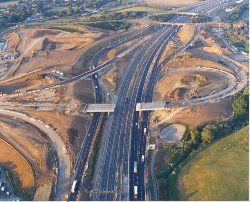
NEW DIMENSION
Picture: Large infrastructure projects will benefit from the new 3D NGM
Early geological maps of the UK, from William Smith onwards, were a response to economic need (coal, water, ores, building materials, transport infrastructure) to sustain the Industrial Revolution and military campaigns. However, like all good field geologists, William Smith had a well developed three- dimensional geological model in his mind. His 1815 map and cross-section represents the first national 3D geological model, communicated using best available technology - the printing press. For nearly two centuries the printed map and its derivatives have remained the signature output of the UK’s core geological survey knowledge-base.
But in today’s rapidly changing i- and e- world, geospatial applications, GPS and the Internet have made mapping on almost any imaginable theme instantly accessible online. The recently released iGeology smartphone app1 has put an entire UK map library’s worth of BGS digital maps into the pockets of the public. While this dataset is still communicated in 2D, software for modelling the form, properties and processes of the subsurface in three-dimensions is now available, affordable and used increasingly for geoscience applications, research and education.
This digital revolution also coincides with the present government’s intention to invest significantly in transport, energy and communications infrastructure. National Infrastructure Plan 20112 highlights several ambitious projects, including the recently approved ‘HS2’ high-speed rail link, which will all demand the best available data and visualisation of landscape and subsurface to aid design and construction, together with process models to forecast impacts from these developments on critical resources like groundwater, and vulnerable environments, like wetlands.
FUTURE PRIORITIES
Going digital releases us from the limitations of sheet-based mapping , allowing us to integrate data and interpretations acquired from a variety of projects that are more tailored to user priorities, including:
- large, multi-disciplinary geoscience survey and modelling projects in conurbations and their catchments (e.g. Glasgow/Clyde and London/Thames projects, currently ongoing), focusing on the Quaternary, Anthropocene and shallow bedrock geology
- responsive geological surveys that develop new partnerships with end-users and address needs of major infrastructure and energy projects including HS2, new-build power stations, major regeneration schemes and the energy and water grids
- new, field-based investigations aimed at quantifying and modelling the physical and engineering properties of superficial deposits and rocks at sample, outcrop and basin resolutions, focusing on discontinuities, fabric and weathering and using new techniques in terrestrial LIDAR, shallow geophysics and remote sensing.
These surveys and observations will be embedded into a new, overarching 3D National Geological Model (NGM) of the UK. For the first time, this will provide us with the means to build and maintain a consistent, spatial knowledge base of the UK subsurface that is scale-independent and can be updated responsively as new data become available.